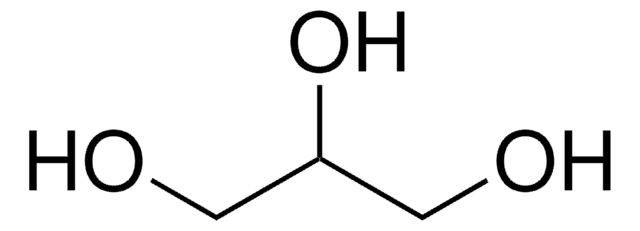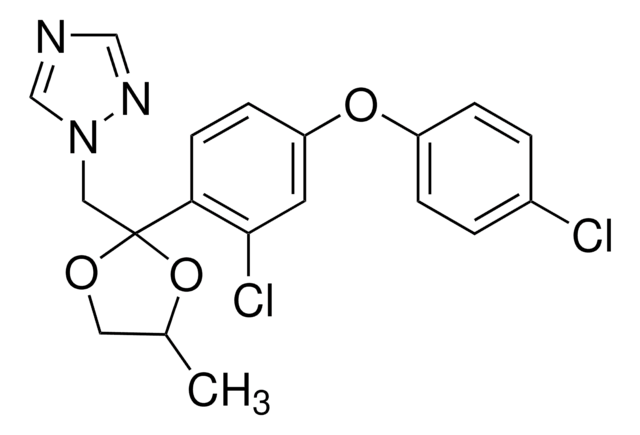49781
Glycérol solution
83.5-89.5% (T)
Synonyme(s) :
1,2,3-Propanetriol
Se connecterpour consulter vos tarifs contractuels et ceux de votre entreprise/organisme
About This Item
Formule linéaire :
HOCH2CH(OH)CH2OH · aq
Numéro CAS:
Poids moléculaire :
92.09 (anhydrous basis)
Beilstein:
635685
Numéro CE :
Numéro MDL:
Code UNSPSC :
50161901
ID de substance PubChem :
Nomenclature NACRES :
NA.28
Produits recommandés
Essai
83.5-89.5% (T)
Forme
viscous liquid
Technique(s)
MALDI-MS: suitable
Impuretés
10.5-16.5% water
Résidus de calcination
≤0.01% (as SO4)
pb
182 °C/20 mmHg (lit.)
Densité
1.252 g/mL at 25 °C (lit.)
Chaîne SMILES
OCC(O)CO
InChI
1S/C3H8O3/c4-1-3(6)2-5/h3-6H,1-2H2
Clé InChI
PEDCQBHIVMGVHV-UHFFFAOYSA-N
Vous recherchez des produits similaires ? Visite Guide de comparaison des produits
Catégories apparentées
Description générale
Glycerol is odourless, colorless, viscous in nature, and exists as a sweet tasting liquid. It can be derived naturally as well as from petrochemical feedstock. Glycerol has a wide variety of applications, and is one of the most valuable and versatile chemical substances in nature. It can be used as an emollient, solvent, sweetening agent, in pharmaceutical formulations, cosmetics, foodstuffs and toiletries. It is very stable and can be easily stored under normal temperature; also it is non-irritating and has no adverse impact to the environment.
Application
Glycerol solution has been used:
- in the preparation of blood mimicking fluid
- in epidermis mimicking films
- as a constituent of nuclei storage buffer
Actions biochimiques/physiologiques
Glycerol has been used as
- a supplement during cell culture of Mycobacterium tuberculosis and Mycobacterium avium.
- a fuel during designing enzymatic biofuel cell.
- a liquid composite matrix with 4-HCCA and 3-aminoquinoline for analysis of neutral and acidic glycans.
- a matrix for fast atom bombardment MS.
- may be employed as liquid matrix for the quantification studies by MALDI (Matrix-assisted laser desorption/ionization mass spectrometry) analysis.
Glycerol is hygroscopic in nature and is soluble in water owing to its three hydrophilic alcoholic hydroxyl groups. It can form both inter- and intramolecular hydrogen bonds, making it a very flexible molecule. The physiologic effect of glycerine is due to cell-mediated immunity, increased IgG production and increased histamine release.
Autres remarques
Substrate for the assay of glycerokinase; glycerol dehydratase; glycerol oxidase
Classe de danger pour l'eau (WGK)
WGK 1
Équipement de protection individuelle
Eyeshields, Gloves
Faites votre choix parmi les versions les plus récentes :
Déjà en possession de ce produit ?
Retrouvez la documentation relative aux produits que vous avez récemment achetés dans la Bibliothèque de documents.
Les clients ont également consulté
Multilayered tissue mimicking skin and vessel phantoms with tunable mechanical, optical, and acoustic properties
Chen AI, et al.
Medical Physics, 43(6), 3117-3131 (2016)
H.U. Bergmeyer, ed.
Methods of Enzymatic Analysis, 2, 216-216 (1983)
Glycerol oxidase from Aspergillus japonicus.
T Uwajima et al.
Methods in enzymology, 89 Pt D, 243-248 (1982-01-01)
Automated end-to-end blood testing at the point-of-care: Integration of robotic phlebotomy with downstream sample processing
Balter ML, et al.
Technology, 1-8 (2018)
Glycerol dehydratase from Aerobacter aerogenes.
B C Johnson et al.
Methods in enzymology, 42, 315-323 (1975-01-01)
Notre équipe de scientifiques dispose d'une expérience dans tous les secteurs de la recherche, notamment en sciences de la vie, science des matériaux, synthèse chimique, chromatographie, analyse et dans de nombreux autres domaines..
Contacter notre Service technique
